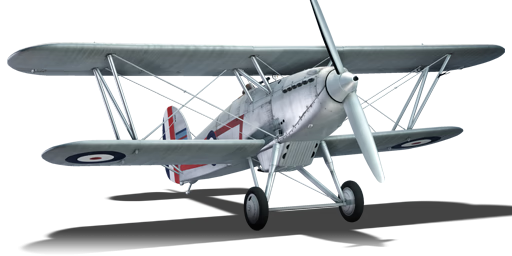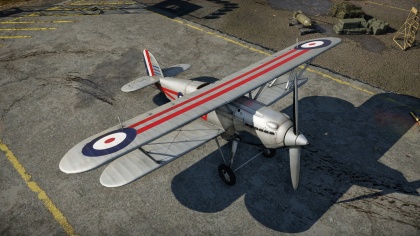Fury Mk I
Contents
| This page is about the British fighter Fury Mk I. For the other version, see Fury Mk II. For other uses, see Fury (Disambiguation). |
Description
The Fury Mk I is a reserve rank I British fighter
with a battle rating of 1.0 (AB/RB/SB). It has been in the game since the start of the Open Beta Test prior to Update 1.27.
The Fury Mk I is one of the three reserve fighters in the British tree - the other two being the Nimrod Mk I (a naval version Fury), as well as the Fury Mk II. As a reserve plane, the Fury isn't a manoeuvrable or fast plane. Its armament, two 7.7 mm Vickers K machine guns, while equivalent to the armament found on most other reserve planes as well as some early rank I planes, can take a while (and a bit of ammo) to destroy targets it will face at its rank such as Bf 109s, CR.42s, I-15s and even lightly armoured Ki-27s and A5Ms. Use Universal or Stealth rounds with the Vickers K guns but keep in mind that unlike the current modelled Brownings as used on Gladiators, Hurricanes and Spitfires, these 7.7 mm guns won't do much damage unless you aim for the most vulnerable parts of your opponent's aircraft.
The Furies in all their variants also turn decently, though they do tend to bleed energy easily and aren't the best planes in climbing or acceleration. The modelled fixed pitch prop will mean not much power is around for climbing at the start of the match - a problem also currently shared with the later Gladiators. If you want to use the Fury, the best advice is to side climb a bit at the start of the match so you at least have some energy to work with. Plan manoeuvres ahead and go for easy targets such as inattentive planes and attackers destroying ground vehicles. Most of the problems with the plane are mitigated in Arcade Battles as traits like engine overheating and wing rip-offs are not modelled in that mode.
General info
Flight performance
Describe how the aircraft behaves in the air. Speed, manoeuvrability, acceleration and allowable loads - these are the most important characteristics of the vehicle.
| Characteristics | |||||||
|---|---|---|---|---|---|---|---|
| Stock | |||||||
| Max Speed (km/h at 4,100 m) |
Max altitude (meters) |
Turn time (seconds) |
Rate of climb (meters/second) |
Take-off run (meters) | |||
| AB | RB | AB | RB | AB | RB | ||
| 384 | 374 | 8100 | 16.3 | 16.9 | 13.6 | 13.6 | 232 |
| Upgraded | |||||||
| Max Speed (km/h at 4,100 m) |
Max altitude (meters) |
Turn time (seconds) |
Rate of climb (meters/second) |
Take-off run (meters) | |||
| AB | RB | AB | RB | AB | RB | ||
| 402 | 394 | 8100 | 15.8 | 16.0 | 19.2 | 15.7 | 232 |
Details
| Features | ||||
|---|---|---|---|---|
| Combat flaps | Take-off flaps | Landing flaps | Air brakes | Arrestor gear |
| ✓ | X | X | X | X |
| Limits | ||||
|---|---|---|---|---|
| Wing-break speed (km/h) |
Gear limit (km/h) |
Combat flaps (km/h) |
Max Static G | |
| + | - | |||
| 520 | ~11 | ~5 | ||
| Optimal velocities | |||
|---|---|---|---|
| Ailerons (km/h) |
Rudder (km/h) |
Elevators (km/h) |
Radiator (km/h) |
| < 260 | < 280 | < 300 | > 200 |
| Compressor (RB/SB) | ||
|---|---|---|
| Setting 1 | ||
| Optimal altitude | 100% Engine power | WEP Engine power |
| 3,705 m | 600 hp | N/A |
Survivability and armour
Examine the survivability of the aircraft. Note how vulnerable the structure is and how secure the pilot is, whether the fuel tanks are armoured, etc. Describe the armour, if there is any, and also mention the vulnerability of other critical aircraft systems.
Armaments
Offensive armament
The Fury Mk I is armed with:
- 2 x 7.7 mm Vickers E machine guns, nose-mounted (600 rpg = 1,200 total)
Usage in battles
With 2 x 7.7 mm Vickers machine guns the Fury Mk I can take down any I rank plane so long as the shots are aimed well.
Manual Engine Control
| MEC elements | ||||||
|---|---|---|---|---|---|---|
| Mixer | Pitch | Radiator | Supercharger | Turbocharger | ||
| Oil | Water | Type | ||||
| Controllable | Not controllable Not auto controlled |
Not controllable Not auto controlled |
Controllable Not auto controlled |
Combined | Not controllable 1 gear |
Not controllable |
Modules
| Tier | Flight performance | Survivability | Weaponry | |
|---|---|---|---|---|
| I | Fuselage repair | Radiator | Offensive 7 mm | |
| II | Compressor | Airframe | New 7 mm MGs | |
| III | Wings repair | Engine | ||
| IV | Cover | |||
Pros and cons
Pros:
- Turns well for a biplane
- Excellent vertical maneuverability
- Incredibly low stall speed
Cons:
- Sluggish in acceleration and climb (equipped with fixed-pitch prop, and no WEP)
- Only has two rifle-calibre machine guns that can sometimes not do too much damage to the target
- Loses energy quite easily, mostly able to turn just once or twice
- Not very beginner-friendly due to its flying characteristics.
- Engine tends to overheat, especially so in hot maps. (RB/SB)
History
Describe the history of the creation and combat usage of the aircraft in more detail than in the introduction. If the historical reference turns out to be too long, take it to a separate article, taking a link to the article about the vehicle and adding a block "/ History" (example: https://wiki.warthunder.com/(Vehicle-name)/History) and add a link to it here using the main template. Be sure to reference text and sources by using <ref></ref>, as well as adding them at the end of the article with <references />. This section may also include the vehicle's dev blog entry (if applicable) and the in-game encyclopedia description (under === In-game description ===, also if applicable).
In-game description
The Hawker Fury was a single engine, single-seat biplane of composite structure which first entered service in May 1931. The Fury was designed by H.G. Hawker Engineering Co. Ltd (Hawker Aircraft Ltd since 1933) under the direction of Sidney Camm. The Fury prototype made its first flight in March 1931 and after a successful test and evaluation period, entered production for service in Britain’s Royal Air Force. However, the Fury was an expensive aircraft and, with Britain being in the grip of a financial depression, initially only enough aircraft were ordered to equip three squadrons; Nos 1, 25 and 43 Squadrons.
An elegant aircraft with streamlined fuselage contours, the Fury Mk.I was the first RAF fighter with a speed exceeding 322 km/h (200 mph).
Most aircraft were equipped with a 525 hp liquid-cooled in-line twelve-cylinder Rolls-Royce Kestrel IIS engine and a wooden twin-bladed Watts propeller, although several alternative powerplants became available during the Fury’s service life.
The Fury's fuselage, wings, and tail had a metal framework and a fabric skin. The skin of the forward fuselage up to the cockpit and the engine cowling was made of duralumin sheets. Ailerons were fitted to the upper wing; nevertheless, due to their large area, they were very responsive and provided the aircraft with a high roll rate.
The armament consisted of two synchronous 0.303 inch Vickers Mk.IV machine guns with 600 rounds per gun, mounted in front of the cockpit. Whilst the Fury was an excellent fighter when it first entered service, it did mark the end of an era as one of the last open cockpit, biplane fighters produced by Britain. Its fixed undercarriage, fabric skin and twin Vickers guns were reminiscent of fighters of the First World War, and when it was replaced in front line service with the RAF in 1939, it truly was a relic of a bygone era.
A total of 117 Fury Mk.I fighters were produced, in five series.
Media
Excellent additions to the article would be video guides, screenshots from the game, and photos.
See also
Links to the articles on the War Thunder Wiki that you think will be useful for the reader, for example:
- reference to the series of the aircraft;
- links to approximate analogues of other nations and research trees.
External links
Paste links to sources and external resources, such as:
- topic on the official game forum;
- encyclopedia page on the aircraft;
- other literature.





